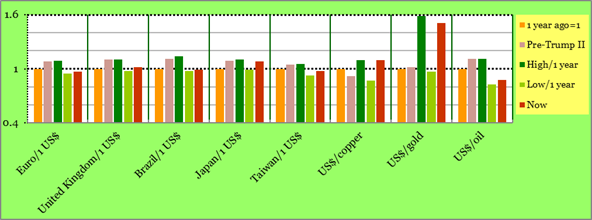

US$ Euro Yen
North America
Caribbean
Central America
South America
Western Europe
Eastern Europe
Russia
Former USSR
Middle East
North Africa
West Africa
East Africa
Southern Africa
South Asia
Pacific Rim
Commodities
Multinational

November 3, 2025 (Next update: November 19, 2025). Visit Search to look at past issues of World Currency Observer (brochure edition).
Among the events of October 2025 with widespread effects on exchange rate movements have been overall movements, and optimism, regarding the trade and tariff relationship between China and the United States, which contributed to an overall improvement in views of prospects for trade developments in many countries around the world. An example of this is the strength of the Brazil real over the last two weeks of October, with the China-US news generally regarded as having helped to reduce the net downward movement of the US$ value of the real on the month to 1%. The Chile peso was up by 1.5% on the month against the US. The Euro was down by 1.75% against US$ over the month of October 2025, and is up by 3.5% since this time last year. The United Kingdom pound was up by 2.75% in October, and down by 2.1% since this time last year. Almost all currencies in the countries of the former USSR were up against the US$ in October, which included a 3.5% upward movement of the Russia rouble against the US$, and a 3.25% rise in the US$ value of the Kazakhstan tenge. There was a 2.75% upward movement in the Nigeria naira (official) against the US$$ in October 2025, and the Ghana cedi was up by 12% - in both cases, due to recent developments in Africa finance, the general attitude to these and to other news of currency appreciation throughout Africa was one of cautious optimism. With regard to the Japan yen: after a sharp decline against the US$ in the first week of the month (attributed around the world to a reduced expectation of future increases in Japan interest rates, due to a change in the Japan political climate with regard to views of the appropriate value of the yen, which was then followed by a downward drift in the value of the yen over the rest of October), the net movement of the Japan yen was a 5% decline against the US$ over the entire month, and a decline of 8% since this time last year. The weakness in the Japan yen was in marked contrast to other Asia currencies - several of which (such as the South Korea won and the Taiwan dollar) also showed weakness, but less so, against the US$ in October. The India rupee showed almost no net movement on the month - after reaching what was characterized as an all-time low against the US$ over the first two weeks of October 2025, the weakness was then reversed, due to optimism on seeing India reach a better tariff deal with the United States. Commodity prices in US$ terms were generally up in October 2025 - among the exceptions were the most commonly exported varieties of rice.
(World Currency Observer will next be updated on November 19, 2025. Visit Search to look at past issues of World Currency Observer (brochure edition). For permission-to-quote enquiries, e-mail World Currency Observer at WCO@briargreen.com.)







